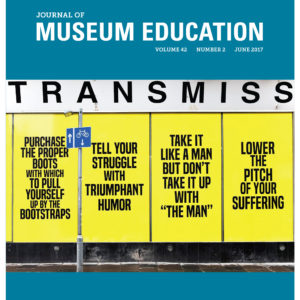Beyond Borders: Expanding Our Access
Our colleague Jon Carfagno candidly outlines in his May blog post, “Retelling the Story of Museum Education Roundtable,” the process we at the Museum Education Roundtable (MER) recently embarked towards an exciting organization-wide transformation. We reflected on our purpose, our audiences and our future to redefine our brand, mission, vision and role. Throughout this process of reflection and change, we sought the input from all of our constituents. One of the areas that drew our attention was that our readers wanted more access to our Journal of Museum Education (JME). Our new user-friendly website was launched this April and connects members online access to every issue of the JME published including the original Roundtable Reports from 1973. We, the two authors of this blog post, also recently edited a virtual special issue (April 2017) that highlights issues as it relates to the AAM conference theme “Gateways for Understanding: Diversity, Equity, Accessibility, and Inclusion in Museums.”
 This conference theme is appropriate in thinking about MER’s new brand and website, the wealth of resources available in the online archive, and what is relevant to museum professionals. The JME has and continues to create new knowledge and understanding in our field while highlighting the many diverse approaches to museum education. This theme is also of particular importance to the two authors of this blog in how we think about our personal and professional work as museum educators.
This conference theme is appropriate in thinking about MER’s new brand and website, the wealth of resources available in the online archive, and what is relevant to museum professionals. The JME has and continues to create new knowledge and understanding in our field while highlighting the many diverse approaches to museum education. This theme is also of particular importance to the two authors of this blog in how we think about our personal and professional work as museum educators.
We not only write this as two museum professionals and MER Board members, we write this as two Asian-American women, children of immigrants, and both now experiencing life as new immigrants (Vivian in Japan and Naomi in Canada). Global citizenship is the way we are now navigating life – and we represent the international Board membership of MER as well as a growing area of interest for our organization. The multi-national and outsider experiences are ones that we both navigate daily and we are not alone. All of these experiences and interactions are relevant to the interrelated issues of diversity, equity, accessibility and inclusion.
They are even more important as we place museums and museum education in a global context and reflect MER’s commitment to the diversity of voices, approaches, disciplines and paradigms in our field.
As museum educators, we must also think about issues of relevance, barriers to learning, and barriers to participation and purpose. Whether or not your museum is accessible to and inclusive of you, does not mean that it is a welcoming space for someone else. Equity work is first an orientation, a critical consciousness and lens through which one begins to see and understand the world and how this will then map to one’s museum’s culture, pedagogical and interpretative approaches and public engagement.
In thinking about the complexity of these issues, we took an opportunity to look at the many articles that have been contributed to the JME over the years. Our March 2017 issue of the JME, “Race, Dialogue and Inclusion: A Museum on the National Stage” and our June 2017 issue “Identifying & Transforming Racism in Museum Education” serve as rich resources. In our Virtual Special Issue which we would like to share again with readers of this blog, we have selected a few works that we feel will assist museum professionals in thinking about these complex issues. There is no one method or process that fits all institutions. Each institution is unique with its own multicultural identity. These selections are meant to enhance the dialogue of diversity, equity, accessibility and inclusion within your institution, so that you and your institution may discover ways to reflect and authentically meet the needs of a wide variety of audiences.

Access the selected articles for free in the Virtual Special Issue until the end of December 2017.
Vivian Kung Haga is a cultural heritage consultant in Japan with over 20 years of experience as an administrator, curator, educator and technologist. Prior to moving to Japan, she was the Director at the Balboa Park Online Collaborative (BPOC), an innovative non-profit organization that assists cultural institutions with their technology initiatives. Prior to BPOC, she was the Deputy Director and Director of Education at the Museum of Photographic Arts, San Diego.
Naomi Ostwald Kawamura is the Executive Director of the Nikkei Place Foundation, based in British Columbia, Canada. Her professional history includes senior leadership positions in museums and arts and cultural organizations. She holds a Master of Education from the Harvard Graduate School of Education and is currently pursuing a Phd at the University of British Columbia.

